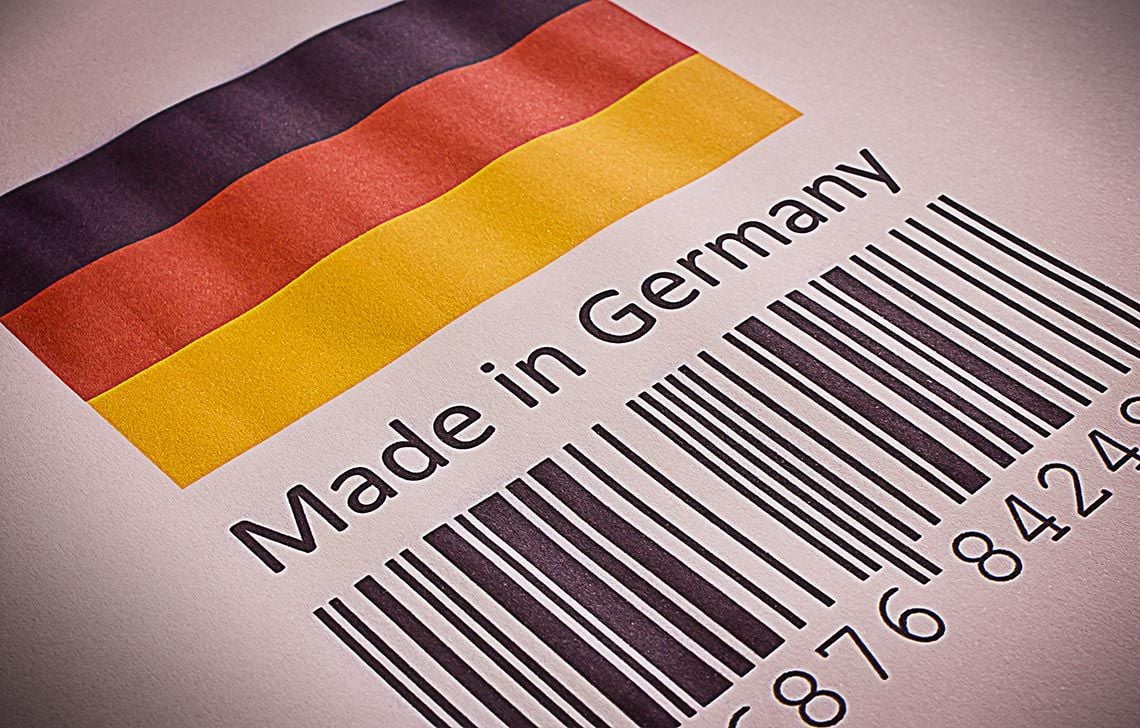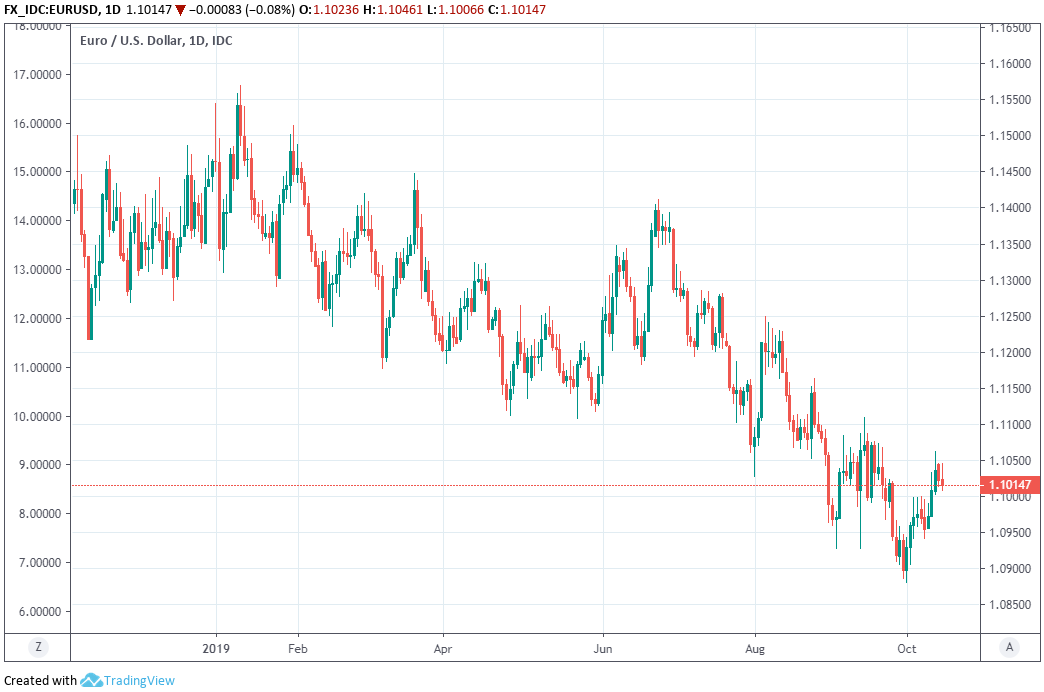Euro-Dollar Rate Consoled by Stability in ZEW Survey but Trade Uncertainty Casts a Long Shadow
- Written by: James Skinner
-

© Adobe Stock
- EUR consoled by ZEW while in retreat on Tuesday.
- ZEW index stabilises on trade and Brexit optimism.
- But failure to seal deals could see slide lower resume.
- Survey comes as doubts over U.S.-China accord pervade.
- EUR continues to draw sellers, citing growth concerns.
- But charts show EUR has based, hint at upside ahead.
The Euro retreated from major rivals Tuesday but received consolation in the form of a surprise bounce in the latest Leibniz Centre for European Economic Research (ZEW) survey, which showed investors becoming less pessimistic in their outlook for the economy during the recent month.
October's ZEW index came in at -22.8, down from -22.5 but well ahead of the consensus for a reading of -27.0. The result means that roughly the same number of analysts expect the German economy to slow in the months ahead as did back in September, when markets had been looking for an increase in the number of pessimistic forecasts. Meanwhile, the index assessing the current situation in Germany declined by a further 5.4 points to -25.3 this month.
The ZEW survey asks 300 financial experts for their opinions on questions relating to the markets and economy. Participants are asked about the current situation as well as their six-months expectations concerning the economy, inflation, interest rates, stock markets and exchange rates. The expectations index has been below its long term average of 21.4 for years now and has sat in negative territory since April 2018, just before the White House began firing tariff announcements in the direction of China.
"We reckon some of the respondents filed their responses factoring-in the surge in optimism late last week, on the back of news of deals in both Brexit and the U.S-China trade negotiations," says Claus Vistesen, chief Eurozone economist at Pantheon Macroeconomics. "The ZEW is not always a reliable indicator for the economic survey data–primarily focusing on the IFO—but the chart shows that it now points to a rebound in the IFO expectations index at the start of Q4."

Above: Euro-to-Dollar rate shown at hourly intervals.
The survey was taken over the seven days to Monday 14 October, which means responses will have been influenced not only by market speculation suggesting a Brexit deal could be reached before year-end, but also mounting expectations the U.S. and China would reach an agreement that averts further hostilities between the world's two largest economies. Both sides have since struck a partial deal, although it's yet to be written on paper and signed by either party.
There's been no shortage of factors weighing on German and Eurozone growth in the last year or more but the 18-month tariff fight between the world's two largest economies at least appears to have done more damage to Germany than either of its two protagonists. Germany is widely believed to be in recession already and the Eurozone economy is forecast by the European Commission to grow by just 1.2% in 2019, down from 1.8% previously.
The U.S. tariff on $250 bn of imports from China was due to rise from 25% to 30% Tuesday until an agreement struck in Washington on Friday led the increase to be abandoned. Europe's single currency was softer Tuesday because the safe-haven Dollar was drawing support from fresh unease over the outlook for U.S.-China relations, as investors eyed the possibility of Friday's accord falling apart before the ink is even dry.
"The market took the news remarkably well yesterday that China is not willing to sign on to the “phase one” trade deal until further talks are held," says John Hardy, chief FX strategist at Saxo Bank. Trump’s desperation to keep the equity market elevated and avoid further economic damage from trade policy ahead of the 2020 elections could yet see him walk back these tariffs, but others have pointed out that there could be more political traction to be found in taking a strong stance against China."

Above: Euro-to-Dollar rate shown at 4-hour intervals.
President Donald Trump said last week the deal struck between him and Chinese Vice Premier Liu He in Washington would take as long as five weeks to get written up and would likely not be signed until the Asia-Pacific Economic Cooperation summit in November. However, both sides have agreed to ceasefires and other forms of truce in the past, only for them to fall apart within weeks and markets appeared to be conscious this week that the very same thing could happen again this month or next.
China is reportedly reluctant to put pen to paper unless the White House agrees to cancel another tariff increase that's still planned for December 15, which will see all of the country's remaining exports to the U.S. hit with a new 15% levy. Both sides have so-far reached an agreement that covers intellectual property protections and currency manipulation, but that also offers U.S. banks access to the large and coveted Chinese market for financial services.
"The R-word is haunting Europe again. The German economy might already be in it. The rest of the eurozone could follow suit: A recession," says Carsten Brzeski, chief economist at ING Germany. "The eurozone economy could benefit from a German recession if it opened doors to more anti-cyclical fiscal policies; there is also a more worrisome scenario possible. If the German government doesn't budge and it sticks to fiscal strictness and structural reforms, seeing recessions as a kind of religious healing process for structural deficiencies in an economy, the pressure increases on the ECB to step in."
With Germany and Europe's economies suffering amid the trade war, the European Central Bank (ECB) has already cut its interest rate and restarted the quantitative easing program it only just wound up back in 2018, as part of an effort to revive the bloc's growth and inflation pulses. But the Frankfurt-based institution is widely seen as having ran out of monetary bullets it can fight the downturn with, leaving markets looking to governments for help.

Above: Euro-to-Dollar rate shown at daily intervals.
The jury is still out on whether Germany, as well the few Eurozone countries that have room within the EU rule framework, will increase spending in quarters ahead although there's no shortage of reasons for them to do so. The bloc faces not only a continuing trade fight, but also the threat of a 'no deal' Brexit at the end of October and a possible White House decision to impose tariffs on imports of cars from Europe in mid-November.
All of those factors could mean headwinds mount for the Euro in the months ahead and explain why there's no shortage of fundamental analysts who're willing to tip the single currency as a sell, although not everybody is bearish in their outlook for Europe's unified unit. Technical analysts at Commerzbank said Tuesday the Euro-to-Dollar rate looks as if it's formed a "base" on the charts and that it could be due an upward correction as a result.
"EUR/USD held steady yesterday following its recent erosion of the four month downtrend and given that the market has recently reversed from the base of the weekly channel at 1.0892, we view the market as a base. We look for recovery to initially the mid September high at 1.1110. A close above here would trigger another leg higher to the 200 day ma at 1.1216," says Karen Jones, head of technical analysis at Commerzbank.
Time to move your money? Get 3-5% more currency than your bank would offer by using the services of a specialist foreign exchange specialist. A payments provider can deliver you an exchange rate closer to the real market rate than your bank would, thereby saving you substantial quantities of currency. Find out more here.
* Advertisement




